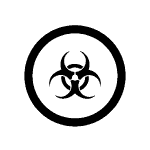Circle of Care is dedicated to our employees’ health, safety, and well-being. We follow WHMIS standards, ensure access to key health and safety information, and provide ongoing training on handling hazardous materials to maintain a safe workplace.
What is WHMIS?
WHMIS (Workplace Hazardous Materials Information System) is Canada’s system for providing health and safety information on hazardous products used in workplaces. It aligns with the global GHS (Globally Harmonized System) to ensure employees have access to important information about the chemicals they may encounter, promoting a safer work environment.
While handling hazardous materials is rare at Circle of Care, it’s still important for you to be aware of WHMIS.
Overview of Healthcare Related Hazard Symbols

Health Hazard
This symbol warns that the product can cause serious, long-term health effects, like cancer or respiratory issues, which may not be immediately obvious. However, with proper handling and storage, such as using gloves and ensuring good ventilation, these products can be safely used. An example of a product that might have this symbol is a cleaning product.

Biohazardous Infectious Materials
Biohazardous materials, like body fluids, are common in hospitals and healthcare settings. Since it’s hard to know which fluids contain harmful organisms, employees should treat all samples as hazardous and always use proper protection, such as wearing gloves and disinfecting the area.

Exclamation Mark
This symbol represents less severe health hazards, like skin or eye irritation, or skin sensitivity. Products with this symbol, like hand sanitizer, can be safely used if proper handling and storage practices are followed.
Your Responsibilities under WHMIS
You have specific responsibilities under WHMIS to ensure your safety and the safety of others. The following outlines your main responsibilities:
- Use Personal Protective Equipment (PPE) as needed.
- Report unsafe conditions, spills or accidents involving hazardous materials to your supervisor.
- Follow safe work procedures by completing WHMIS training.
- Keep your work area clean and store hazardous materials properly to prevent spills or contamination.
- Read labels and Safety Data Sheets (SDS) to understand hazards, safe handling, and emergency procedures for the products you are handling.
Please complete the following poll/quiz to test your knowledge of WHMIS symbols and information.
